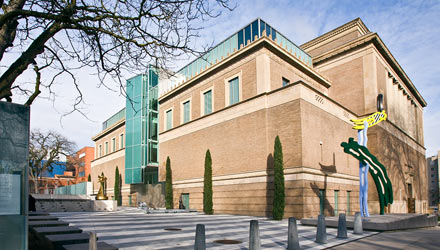 The Portland Museum of Art, or PMA, is the largest and oldest public art institution in the U.S. state of Maine. Founded as the Portland Society of Art in 1882, it is located in the downtown area known as The Arts District in Portland, Maine.
The Portland Museum of Art, or PMA, is the largest and oldest public art institution in the U.S. state of Maine. Founded as the Portland Society of Art in 1882, it is located in the downtown area known as The Arts District in Portland, Maine.
The PMA used a variety of exhibition spaces until 1908; that year Margaret Jane Mussey Sweat bequeathed her three-story mansion, now known as the McLellan House, and sufficient funds to create a gallery in memory of her late husband, Lorenzo De Medici Sweat, who was a U.S. Representative. Noted New England architect John Calvin Stevens designed the L. D. M. Sweat Memorial Galleries, which opened to the public in 1911.
Over the next 65 years, as the size and scope of the exhibitions expanded, the limitations of the Museum’s galleries, storage, and support areas became apparent. In 1976, Maine native Charles Shipman Payson promised the Museum his collection of 17 paintings by Winslow Homer. Recognizing the Museum’s physical limitations, he also gave $8 million toward the building of an addition to be designed by Henry Nichols Cobb of I. M. Pei & Partners. Construction began on the Charles Shipman Payson Building in 1981, and within two years the $8.2 million facility was opened to the public.
The Museum’s collection includes more than 18,000 artworks, dating from the 18th century to the present. The PMA’s collection features works by artists such as Winslow Homer, Marsden Hartley, John Marin, Louise Nevelson, Andrew Wyeth and John Greenleaf Cloudman. The Museum has the largest European collection in Maine.
Presentations Prints in the collection:
Bill Jacklin
Will Barnet
Richard Bosman
Karl Schrag
April Gornik
Stanley Boxer
Paul Resika
Warrington Colescott
John Walker
